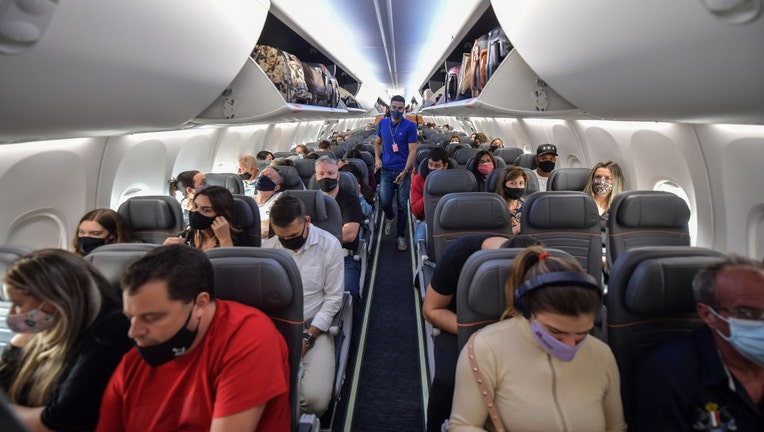Senators push for FAA to evaluate airplane seat sizes

FILE-Passengers take their seats before take off in a Boeing 737 MAX airplane. (NELSON ALMEIDA/AFP via Getty Images)
Airplane seat sizes are the focus of proposed legislation by two Democratic senators pushing for the Federal Aviation Administration to evaluate to determine if they are too small.
In the legislation, Senators Tammy Duckworth and Tammy Baldwin would require the FAA to perform new airplane cabin evacuation tests with more realistic conditions and issue standards, including the size and space between seats, CNN reported.
The bill would also require FAA standards to consider seat size, the layout of rows, the presence of carry-on bags, purses, and briefcases – even though passengers are informed to leave the items behind – and a real-world range of passengers, including children, seniors and people with disabilities, the Associated Press noted.
RELATED: Flight attendants renew push for infants to have their own seats
FOX Television Stations obtained a statement from the agency that says "the FAA is reviewing the thousands of comments it received on whether current seat size and spacing affect passenger evacuation."
Under the FAA Reauthorization Act of 2018, the agency issued rules for passenger safety regarding the minimum dimensions, including seat pitch, width, and length of passenger seats on airplanes operated by air carriers in interstate air transportation or interstate air transportation, the FAA said.
The FAA received more than 26,000 comments from the public seeking feedback on the minimum dimensions of passenger seats for safety, including in a plane evacuation.
An aviation safety panel assessed nearly 300 real-world evacuation events over the past 10 years, including the passenger demographics that make up the flying public. The panel concluded that overall safety emergency evacuations are high.
RELATED: United Airlines changes family seating policy
Duckworth’s push for better seats involves the safety of passengers to evacuate an airplane if there is an emergency.
In 2019, the FAA ran drills on an aircraft cabin mock-up, and all the volunteers participating were healthy adults under 60. The AP noted that an FAA administrator at the time acknowledged that the tests provided "useful, but not necessarily definitive information."
Duckworth argued that the 2019 FAA test was unrealistic because it only used healthy adults under 60 — no children, no seniors, and nobody with disabilities took part, the AP reported.
The FAA conducted those tests after Congress ordered the agency to create minimums for the size of airline seats and the distance between rows. Lawmakers said new standards are necessary because Americans are getting heavier while airlines are cramming more plane seats.
According to the AP, the FAA resisted efforts to set minimum standards for seat size and distance between rows, saying those are issues of comfort, not safety. A federal appeals court ruled in the agency’s favor this year.
Airlines have made seats thinner and reduced legroom to squeeze more passengers on every flight. The distance from a seatback to the one in front or behind it — airlines call that "pitch" — used to measure about 35 inches; now it’s 28 inches on some airlines and 31 or 32 inches on others.
The Associated Press contributed to this report. This story was reported from Washington, D.C.

